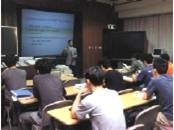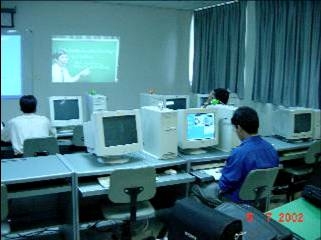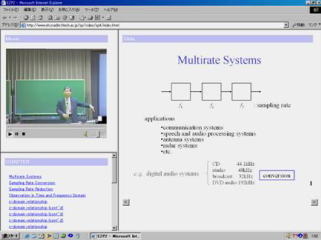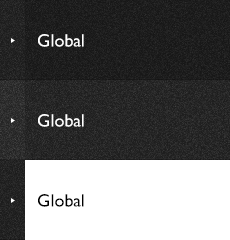In 1993, Tokyo Institute of Technology began offering its students graduate-level courses conducted in English. Three years later, the Institute's Center for Research and Development of Educational Technology (CRADLE) established a system called " Academic Network for Distance Education by Satellite " (ANDES) for delivery of remote lectures.
Some of the courses taught in English were transmitted to Thailand using the ANDES system starting in 2002. Through Thailand's National Science and Technology Development Agency (NSTDA) — which had signed a cooperation agreement with Tokyo Tech the previous year — the recipients of the lectures were Asian Institute of Technology (AIT) and King Mongkut's Institute of Technology Ladkrabang (KMITL).

The system enabled students in Thailand to take Tokyo Tech lectures in real time. In Thailand, video signals from the satellite tuner were projected onto a screen by a liquid crystal projector, and lecture materials, downloaded in advance from the Internet, were projected by a separate liquid crystal projector. An Internet-based video conference system was used for students to ask questions during the lectures. As the Internet environment in Thailand was not as advanced when the project began, it was impractical to rely on the Internet for regular weekly lectures, but even when network issues led to poor audio or video connections, lecturers could take questions from students using chat functions. When connections were particularly bad, they could receive questions by email and provide answers during the next week's class.
Within 20 minutes of the conclusion of each 90-minute lecture, learning materials meeting SCORM (Shareable Content Object Reference Model) standards were uploaded to a server for use by students in both Japan and Thailand.
The courses were determined based on requests from the Thai side and the willingness of the Tokyo Tech lecturers. In AY 2003 and AY 2004, the following courses were taught:
All courses were taught in English, and efforts were made to avoid creating new burdens for the lecturers. To bridge differences in the academic calendars and credit structures of Tokyo Tech and the foreign universities, a lecturer and a TA were assigned on the Thai side to conduct exercises and attend to the needs of each course. In addition, Tokyo Tech lecturers visited Thailand at least once during each course to teach in person and meet their students face-to-face. This led to increased motivation among the students.
With a two-hour time difference between Japan and Thailand, lectures scheduled for 9 a.m. Japan time meant an early 7 a.m. start time in Thailand, but scheduling lectures any later would have conflicted with course timetables on the Thai side. Thanks to Thai counterparts' flexibility, a mutually convenient lecture schedule was made possible.
Thai lecturers indicated that they appreciated the lecture contents and delivery methods. Students, in response to questionnaires conducted every semester, reported satisfaction with the video and audio for the lectures and evaluated the lecture contents as being difficult but interesting. On average, AIT students spent 122 minutes a week preparing for lectures and 101 minutes per week reviewing them. Because almost all of the AIT students lived in on-campus dormitories, they had good relationships with their courses' TAs, and this may also have played a role in their high level of motivation.
Lecturers' takeaways from the experience included the following:
- 1.
-
Compared to in-person lectures, remote lectures should allocate more time for Q&A.
- 2.
-
Lecture notes should be given in advance.
- 3.
-
e-Learning materials are very effective in supporting students' review of lectures.
- 4.
-
Locally-based TAs play an important role.
- 5.
-
It is important to encourage active communication between students.
- 6.
-
Face-to-face interaction with lecturers increases students' motivation.
These ideas were applied to the further development of the program.
. Any information published on this site will be valid in relation to Science Tokyo.





